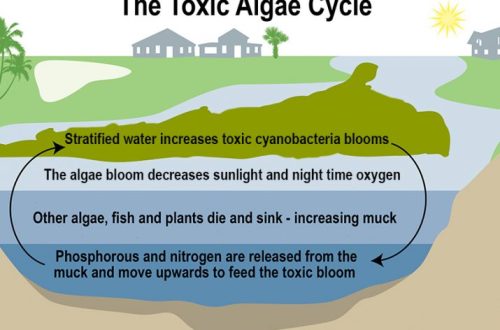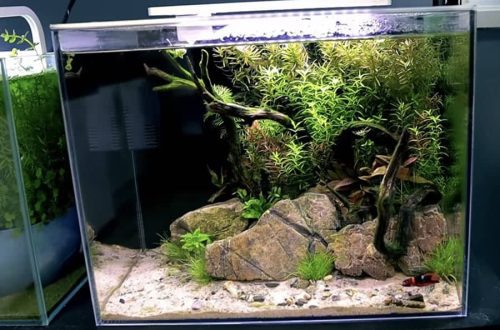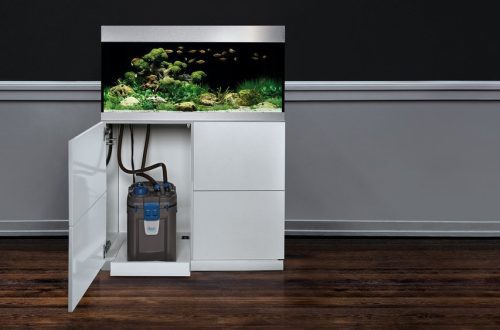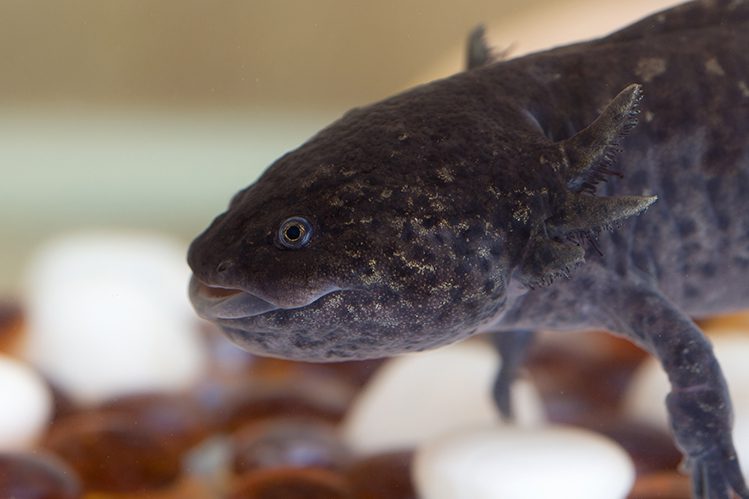
Axolotl in the aquarium: caring for a pet dragon
The axolotl is the perfect pet for those who have been reading stories about dragons since childhood and have always dreamed of having their own. The axolotl is beautiful, friendly to the owners, has curious habits, lives long enough. But for the well-being of this cute inhabitant of the underwater world, it is necessary to follow several important rules, which we will talk about today.
Contents
Where did the dragon come from?
Axolotl is a neotenic larva of some species of amphibian ambystoma. Neotenic – having reached puberty and the end of the development of the organism at the larval or other early stage of life. That is, an axolotl may not outwardly turn into an adult ambistoma, but live a full life and give offspring, give life to other axolotls. Usually the axolotl in the home aquarium is the larva of the Mexican ambystoma or tiger ambystoma.
In nature, the axolotl can become an adult ambistoma under the influence of negative environmental factors: the native pond has dried up or extreme heat has set in. At home, such experiments should not be carried out, they almost always lead to the death of a pet. To make such a transformation without prejudice to the ward is possible only under the guidance of a herpetologist.
Axolotl is not just a water dragon, but also a real wizard. If this pet loses a leg or tail as a result of an accident, new ones will grow in their place. This amazing ability of the axolotl to regenerate makes it a truly extraordinary pet.
If from an early age to accustom the axolotl to hands, he will allow himself to be stroked. But if you need to drop your ward out of the aquarium for a while, it is better to use a ceramic or plastic container without sharp edges for this, because the skin of axolotls is very delicate.

The beauties of the underwater world
The most familiar image of an axolotl is pale pink, with bright eyes and a muzzle expression that looks like a smile from ear to ear. Indeed, all axolotls look like they are constantly smiling. But in nature, the light color of axolotls is rare, because this makes them vulnerable to predators. There are a wide variety of color options. Axolotl can be white, yellow, black, gray, brown, brown, and so on, a whole palette of natural shades is obtained.
The head of the axolotl is large and very wide, the eyes are small. Three pairs of external gills are located on the sides of the head, forming a decorative collar. Has a streamlined body shape. The axolotl looks like a newt and a lizard at the same time.
The water dragon can grow up to 45 centimeters in length. But the axolotl in a home aquarium rarely reaches a size of more than 30 centimeters, with an average of about 23 centimeters. In nature, this outlandish representative of the fauna can live for 20 years. Axolotl in a home aquarium usually lives for about 10 years.
Aquarium for axolotl
In many ways, the behavior of the axolotl in the aquarium is dictated by its unusual respiratory system and environmental factors. The water dragon breathes through gills, lungs, and skin. If there is little oxygen in the water, the axolotl can rise to the surface of the water and inhale air with its lungs. But in this case, the beautiful external gills will begin to atrophy. It is better to provide your ward with oxygenated clean water. This requires a filter and an aerator.
Two adults need an aquarium of 100 liters. If your axolotl prefers to live alone, you can put it in an aquarium with a volume of about 40 liters. As a soil, it is better to choose sand. Complete the picture with stones without sharp edges, large enough so that the pet does not accidentally swallow them. Axolotls are nocturnal, so don’t go overboard with lighting. But they will be very happy with shelters like caves or grottoes.
Axolotls, like fish, are harmful nitrogenous compounds. Change a third of the water in your axolotl tank weekly. Sometimes you can replace half the volume of water. Drip tests help you monitor water quality.
And now the hardest part. For axolotl, the water temperature in the aquarium should be from +19 to +21. If it is warmer in the aquarium, the pet’s metabolism will be disturbed, and health will worsen. Too warm water creates a risk of disease for the axolotl and is clearly not conducive to longevity.
Most aquarists refuse the idea of having an axolotl precisely because of the inability to provide him with the desired temperature regime. If you live on the shady side of the house, on the ground floor, in a cool place, and even with air conditioning, it will be easier for you to create conditions for such a pet.
How to cool the water in an axolotl aquarium? In addition to air conditioning, a fan over the water can help. There are also special fans for the aquarium. And also – a cooling unit for an aquarium, which is called a refrigerator or chiller, this device drives water through itself and cools it. But if the sun shines through your window all year round, and central heating is also working in the house in winter, even an aquarium chiller may not be able to cope.
Who can befriend
The cute axolotl is a predator, but it itself has a sensitive cover and gills. The safest neighbor for him is another axolotl. If this is a heterosexual pair, then, starting from the age of one, axolotls can begin to lay fertilized eggs, say, on the leaves of aquarium plants. If you want to breed small axolotls, it is better to transfer the future parents to another aquarium or transfer the eggs themselves to another aquarium.
No need to hook the axolotl to the fish. They have different temperatures. The axolotl will hunt small fish, and larger fish will hunt it, they can bite the gills. Turtles and frogs are tribesmen with whom the axolotl may have skirmishes over territory.
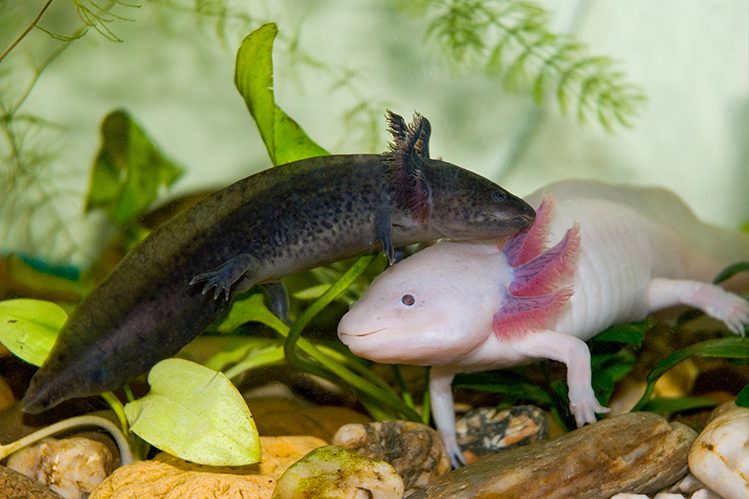
What to feed the axolotl?
Although the water dragon is a predator, its teeth are designed only to hold prey, and not tear it apart. Before acquiring a new pet, carefully study what you can feed the axolotl.
There is a special ready-made food for axolotls. But it is necessary to add protein food, live food to the diet. Suitable bloodworm, cherry shrimp, cut worms, juvenile fish – neon, parsing. You can give fillets of low-fat marine fish of low-fat varieties (cod, pollock). Feed cockroaches or crickets are also possible, but only without a head and paws.
Water dragons love to eat, but it’s better to underfeed them a little than overfeed them. As long as the axolotl is less than 15 centimeters long, it needs to eat daily until it is full. When the pet stops responding to food, it will mean that he is full. And while he is still small, from live food he can only bloodworms. An axolotl that has grown up to 15 centimeters in length needs to be fed every other day. The largest portion of food for the day should be the size of the head of your ward.
The gastrointestinal tract of the axolotl, like the respiratory system, is full of surprises. The water dragon cannot eat the meat of mammals, he will not be able to digest such food. The meat of warm-blooded animals (chicken fillet, etc.) is dangerous for the health of the axolotl. Food for fish, turtles is also not suitable. A predatory dragon does not need to be given vegetables, fruits. In no case do not feed your ward with maggots, otherwise they, swallowed whole, will bite the axolotl from the inside. River fish, fatty marine fish, flies and spiders are also on the axolotl stop list.
Axolotl requires care and attention. Treat your water dragon with care, love and protect it, and a smiling pet will delight you for many years!



